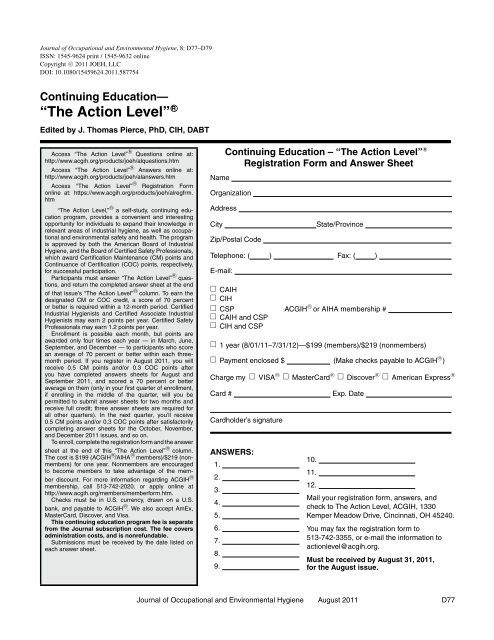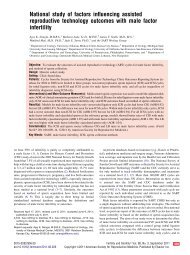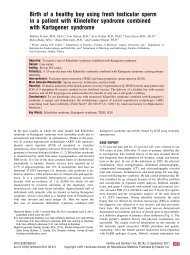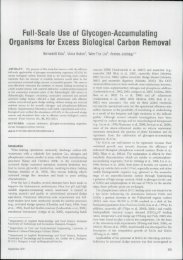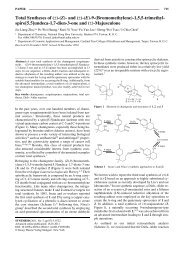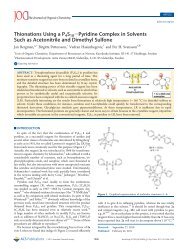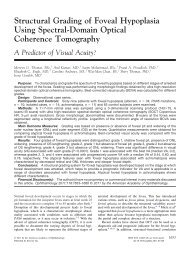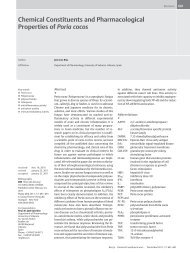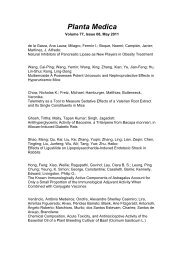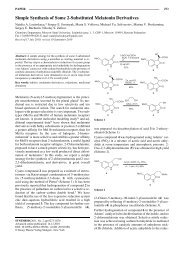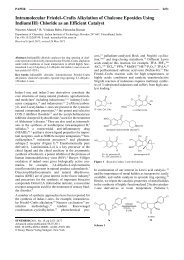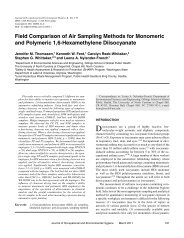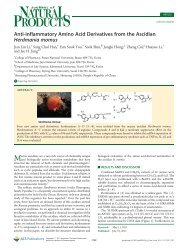“The Action Level”R
“The Action Level”R
“The Action Level”R
Create successful ePaper yourself
Turn your PDF publications into a flip-book with our unique Google optimized e-Paper software.
Journal of Occupational and Environmental Hygiene, 8: D77–D79<br />
ISSN: 1545-9624 print / 1545-9632 online<br />
Copyright c○ 2011 JOEH, LLC<br />
DOI: 10.1080/15459624.2011.587754<br />
Continuing Education—<br />
<strong>“The</strong> <strong>Action</strong> Level” ○R<br />
Edited by J. Thomas Pierce, PhD, CIH, DABT<br />
Access <strong>“The</strong> <strong>Action</strong> Level” ○R Questions online at:<br />
http://www.acgih.org/products/joeh/alquestions.htm<br />
Access <strong>“The</strong> <strong>Action</strong> Level” ○R Answers online at:<br />
http://www.acgih.org/products/joeh/alanswers.htm<br />
Access <strong>“The</strong> <strong>Action</strong> Level” ○R Registration Form<br />
online at: https://www.acgih.org/products/joeh/alregfrm.<br />
htm<br />
<strong>“The</strong> <strong>Action</strong> Level,” ○R a self-study, continuing education<br />
program, provides a convenient and interesting<br />
opportunity for individuals to expand their knowledge in<br />
relevant areas of industrial hygiene, as well as occupational<br />
and environmental safety and health. The program<br />
is approved by both the American Board of Industrial<br />
Hygiene, and the Board of Certified Safety Professionals,<br />
which award Certification Maintenance (CM) points and<br />
Continuance of Certification (COC) points, respectively,<br />
for successful participation.<br />
Participants must answer <strong>“The</strong> <strong>Action</strong> Level” ○R questions,<br />
and return the completed answer sheet at the end<br />
of that issue’s <strong>“The</strong> <strong>Action</strong> Level” ○R column. To earn the<br />
designated CM or COC credit, a score of 70 percent<br />
or better is required within a 12-month period. Certified<br />
Industrial Hygienists and Certified Associate Industrial<br />
Hygienists may earn 2 points per year. Certified Safety<br />
Professionals may earn 1.2 points per year.<br />
Enrollment is possible each month, but points are<br />
awarded only four times each year — in March, June,<br />
September, and December — to participants who score<br />
an average of 70 percent or better within each threemonth<br />
period. If you register in August 2011, you will<br />
receive 0.5 CM points and/or 0.3 COC points after<br />
you have completed answers sheets for August and<br />
September 2011, and scored a 70 percent or better<br />
average on them (only in your first quarter of enrollment,<br />
if enrolling in the middle of the quarter, will you be<br />
permitted to submit answer sheets for two months and<br />
receive full credit; three answer sheets are required for<br />
all other quarters). In the next quarter, you’ll receive<br />
0.5 CM points and/or 0.3 COC points after satisfactorily<br />
completing answer sheets for the October, November,<br />
and December 2011 issues, and so on.<br />
To enroll, complete the registration form and the answer<br />
sheet at the end of this <strong>“The</strong> <strong>Action</strong> Level” ○R column.<br />
The cost is $199 (ACGIH ○R /AIHA ○R members)/$219 (nonmembers)<br />
for one year. Nonmembers are encouraged<br />
to become members to take advantage of the member<br />
discount. For more information regarding ACGIH ○R<br />
membership, call 513-742-2020, or apply online at<br />
http://www.acgih.org/members/memberform.htm.<br />
Checks must be in U.S. currency, drawn on a U.S.<br />
bank, and payable to ACGIH ○R . We also accept AmEx,<br />
MasterCard, Discover, and Visa.<br />
This continuing education program fee is separate<br />
from the Journal subscription cost. The fee covers<br />
administration costs, and is nonrefundable.<br />
Submissions must be received by the date listed on<br />
each answer sheet.<br />
Name<br />
Continuing Education – <strong>“The</strong> <strong>Action</strong> Level” ○R<br />
Registration Form and Answer Sheet<br />
Organization<br />
Address<br />
City State/Province<br />
Zip/Postal Code<br />
Telephone: ( ) Fax: ( )<br />
E-mail:<br />
CAIH<br />
CIH<br />
CSP ACGIH ○R<br />
or AIHA membership #<br />
CAIH and CSP<br />
CIH and CSP<br />
1 year (8/01/11–7/31/12)—$199 (members)/$219 (nonmembers)<br />
Payment enclosed $ (Make checks payable to ACGIH ○R<br />
)<br />
Charge my VISA ○R MasterCard ○R Discover ○R American Express ○R<br />
Card # Exp. Date<br />
Cardholder’s signature<br />
ANSWERS:<br />
1.<br />
2.<br />
3.<br />
4.<br />
5.<br />
6.<br />
7.<br />
8.<br />
9.<br />
10.<br />
11.<br />
12.<br />
Mail your registration form, answers, and<br />
check to The <strong>Action</strong> Level, ACGIH, 1330<br />
Kemper Meadow Drive, Cincinnati, OH 45240.<br />
You may fax the registration form to<br />
513-742-3355, or e-mail the information to<br />
actionlevel@acgih.org.<br />
Must be received by August 31, 2011,<br />
for the August issue.<br />
Journal of Occupational and Environmental Hygiene August 2011 D77
Continuing Education –<br />
<strong>“The</strong> <strong>Action</strong> Level” ○R<br />
QUESTIONS 8(5)<br />
Effects of Forearm vs. Leg Submersion in Work<br />
Tolerance Time in a Hot Environment While Wearing<br />
Firefighter Protective Clothing<br />
Charles P. Katica, Robert C. Pritchett, Kelly L. Pritchett, Andrew<br />
T. Del Pozzi, Gytis Balilionis, and Tim Burnham<br />
1. In the article, the average WBGT temperature of the<br />
environmental chamber was .<br />
a. ∼ 30.8 ± 0.7 ◦ C<br />
b. ∼ 35.2 ± 0.8 ◦ C<br />
c. ∼ 32.8 ± 0.9 ◦ C<br />
d. ∼ 37.2 ± 0.8 ◦ C<br />
2. In the article, the overall findings found an increase of<br />
following lower leg submersion in cool water.<br />
a. 18%<br />
b. 22%<br />
c. 24%<br />
d. 28%<br />
Evaluation of Sampling Methods for Measuring Exposure<br />
to Volatile Inorganic Acids in Workplace Air.<br />
Part 1: Sampling Hydrochloric Acid (HCL) and Nitric<br />
Acid (HNO3) from a Test Gas Atmosphere<br />
Alan Howe, Darren Musgrove, Dietmar Breuer, Krista Gusbeth,<br />
Andreas Moritz, Martine Demange, Véronique Oury, Davy<br />
Rousset, and Michel Dorotte<br />
3. When volatile acids such as hydrochloric acid and<br />
nitric acid are sampled using a sodium carbonateimpregnated<br />
quartz fiber filter and a prefilter, more<br />
reliable estimates of exposure are obtained than when<br />
the acids are sampled using a silica gel sorbent tube.<br />
This is because volatile acids can be present in the<br />
air in the form of both mist and vapor and, while filter<br />
sampling methods typically collect the inhalable fraction<br />
of airborne particles, silica gel tubes significantly undersample<br />
acid mist droplets. True or False?<br />
4. Measurement of exposure to volatile acids can be<br />
subject to both positive and negative interference, even<br />
if a prefilter is used, potentially leading to high or low<br />
results. True or False?<br />
Implementation of a Quantitative Real-Time PCR<br />
Assay for the Detection of Mycobacterium immunogenum<br />
in Metalworking Fluids<br />
Glenn Rhodes, Alexandra Fluri, Andrea Ruefenacht, Marco<br />
Gerber, and Roger Pickup<br />
5. Quantitative real-time PCR assays detect .<br />
a. DNA<br />
b. antigens<br />
c. RNA<br />
d. enzymes<br />
6. The term “cell equivalents” (CE) is used because<br />
obtaining accurate cell counts of mycobacteria is difficult<br />
due to what physiological feature?<br />
a. slow growth<br />
b. rapid growth<br />
c. cell clumping<br />
d. low cell densities<br />
Personal PM2.5 Exposure Among Wildland Firefighters<br />
Working at Prescribed Forest Burns in Southeastern<br />
United States<br />
Olorunfemi Adetona, Kevin Dunn, Dan Hall, Gary Achtemeier,<br />
Allison Stock, and Luke P. Naeher<br />
7. and are the chief occupational<br />
woodsmoke inhalation exposures for wildland<br />
firefighters.<br />
a. Volatile organic compounds; carbon dioxide<br />
b. Carbon monoxide; respirable particulate matter<br />
c. Nitrogen oxides; ozone<br />
d. Lead; benzene<br />
8. Factors that may limit the utility of using carbon monoxide<br />
as a proxy for respirable particulate matter exposure in<br />
smoke from forest fires for wildland firefighters include:<br />
a. Job task/location (i.e., working fire line on foot, driving<br />
bulldozer, flying helicopter).<br />
b. Exposure to emissions from trucks, mules (4wheelers),<br />
and other vehicles used for managing and<br />
fighting forest fires.<br />
c. Time and location of sampling (i.e., sampling firefighters<br />
at base camp for overnight exposures vs. sampling<br />
firefighters at fire line during working/fighting<br />
forest fires).<br />
d. All of the above<br />
Ice Cooling Vest on Tolerance for Exercise Under<br />
Uncompensable Heat Stress<br />
Glen P. Kenny, Andrew R. Schissler, Jill Stapleton, Matthew<br />
Piamonte, Konrad Binder, Aaron Lynn, Christopher Q. Lan,<br />
and Stephen Hardcastle<br />
9. Aging is associated with a progressive decrease in the<br />
physical work capacity and reductions in the capacity to<br />
dissipate heat. Using a cooling vest would likely reduce<br />
the level of thermal and cardiovascular strain to the<br />
same extent, therefore resulting in a similar exposure<br />
time in an older worker compared with a younger worker<br />
performing a similar intensity work protocol. True or<br />
False?<br />
10. An ice cooling vest worn under the protective garment<br />
was shown to increase exercise duration by ∼12%<br />
compared with the protective garment-only condition, yet<br />
D78 Journal of Occupational and Environmental Hygiene August 2011
the level of cardiovascular strain (as measured by heart<br />
rate) at the end of the exercise was similar. This is likely<br />
due to a greater sweat-induced reduction in central blood<br />
volume associated with the longer duration of exercise<br />
performed with the ice vest under the protective garment.<br />
True or False?<br />
Validation of the Criteria for Initiating the Cleaning<br />
of Heating, Ventilation, and Air-Conditioning (HVAC)<br />
Ductwork Under Real Conditions<br />
Jacques Lavoie, Geneviève Marchand, Yves Cloutier, and<br />
Jérôme Lavoué<br />
11. Which country does not have criteria for initiating cleaning<br />
of nonporous ductwork?<br />
a. France<br />
b. Finland<br />
c. Great Britain<br />
d. United States<br />
12. Under real conditions, which sampling method(s) of the<br />
surface dust in the duct yield(s) the most accurate results<br />
and the smallest standard deviation?<br />
a. NADCA method<br />
b. IRSST method<br />
c. ASPEC method<br />
d. NADCA and IRSST methods<br />
Answers to the August 2011 <strong>“The</strong> <strong>Action</strong> Level” ○R<br />
Questions will be available on-line (www.acgih.org/<br />
Products) on September 9, 2011.<br />
Journal of Occupational and Environmental Hygiene August 2011 D79


